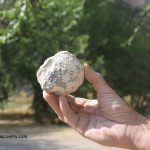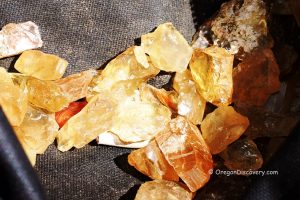
💎 Thunderegg is the official state rock of Oregon
Formed millions of years ago, Thunderegg (Thunder egg) is a round nodule-like rock formation, filled with agate, jasper, opal, and/or quartz crystals. Thunderegg is also called agate-filled or jasper-filled nodules. Typically, the size is from two to six inches in diameter. Rarely eggs can be one to three feet long and weigh over a ton. Some specimens contain two or three eggs connected together.
The exterior surface is white-gray to reddish-brown, looks rough and unattractive but the inner content may surprise you with its impressive crystal formation and colorful mineral patterns. To reveal the natural beauty of eggs, they should be cut in half and polished.
The name was given according to an old legend of the Warm Springs Indians. Two neighboring snow-capped picks - Mount Jefferson and Mount Hood got angry with each other and threw eggs of Thunderbirds which were nestled in both mountains. "Thunder spirits of the mountains who lived in the craters hurled the nodules to the accompaniment of much lightning and thunder".

Thunderegg Formation
The oval-shaped thundereggs have been formed in the rhyolite lava flows and tuffs within the gas or steam pockets that served as molds. The pocket cavity was filled with silica-rich fluids and later solidified and crystallized. Mineral impurities are collected along the bands creating concentric colorful rings.
Note. Hollow thunder eggs are known as geodes but not all geodes are thunder eggs.
How Much Are Thundereggs Worth?
A value of a cut in half and polished thunderegg depends on the size and its fillings and range from a few to a hundred dollars. Specimens with scenic moss or plumes looking like plants or flowers are among the most valuable eggs and can cost up to $200.
How to Spot Thundereggs?
Though thundereggs appear lke rocks, they can be easily identified by the abnormally round and bumpy brown-gray surface. Usually, thundereggs lie relatively close to the Earth's surface, embedded in the clay of the tuff, where they were formed. During the time, the tuff has been decayed to soft mud and clay, making rock-like thundereggs noticeable.
Where to Find Thundereggs in Oregon?
Oregon produces a great variety of thunder eggs that are known for their various colors and styles. Central and Eastern Oregon is the most popular region in the world for thundereggs hunting. The best productive areas are located in the Ochoco National Forest, in the high desert of Central Oregon near Prineville and Madras, and in Succor Creek Creek Canyon of Eastern Oregon.
Canyon Rim Thunderegg Bed produces wonderful thundereggs...
A remote fee-digging collecting area is a popular site to collect stunning thundereggs...
White Fir Springs is a public rockhounding site that produces unique jasper-filled thundereggs...
Whistler Springs is a public rockhounding site producing agate-filled thundereggs...
Richardson’s Rock Ranch is known for its world-famous thunderegg deposits...
Crane Creek Thunderegg Bed is a remote destination in the Fremont National Forest...
The site provides opportunities for hiking, rockhounding, and camping...
 Succor Creek State Natural Area
Succor Creek State Natural Area
Succor Creek Canyon is an excellent spot for hiking, rockhounding, and camping...
You May Also Like
Gems and Minerals in Oregon. Oregon Department of Geology and Mineral Industries. OD http://www.oregongeology.org.
Dan R. Lynch, Bob Lynch. Rocks & Minerals of Washington and Oregon: A Field Guide to the Evergreen and Beaver States (Rocks & Minerals Identification Guides). 2012.












I’m trying to find a price on a possible mutton fat nephrite piece of Illinois River in Selma Oregon